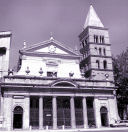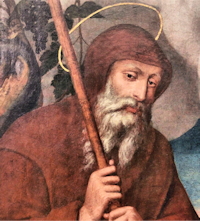Lent: April 2nd
Wednesday of the Fourth Week of Lent; Opt. Mem. of St. Francis of Paola, Hermit
» Enjoy our Liturgical Seasons series of e-books!
The first reading from Isaiah represents one of the most striking passages of the Bible that affirms the love of God for his people. It was a message of consolation addressed to the Jewish captives in Babylon promising them the joys of Messianic times. We are also captives and exiles because of our sins and human failings. Our deliverance is also near. The Messiah will come to us at Easter to give us all the blessings promised by God in this reading. —St. Andrew Bible Missal
Today is the Optional Memorial of St. Francis of Paola (1416-1507). Francis was born at Paola in Calabria; after living as a hermit for five years (from the age of fourteen to nineteen) he gathered around him some companions with whom he led the religious life. This was the origin of a new order, to which he gave the name of Minims, that is "the least" in the house of God. Pope Sixtus IV sent him to France to help Louis XI on his deathbed. He remained there and founded a house of his Minims at Tours.
Meditation for Wednesday of the Fourth Week of Lent
As the pathways of Lent draw ever closer to Calvary, the liturgy multiplies its images of the Messianic Age—the Kingdom of God—that is being inaugurated in the person of Jesus: in his preaching, in his healings and other “signs,” and, ultimately, in his atoning death, vindicated in the Resurrection. Thus Isaiah in the Old Testament reading for today’s Mass speaks of the “time of favor,” the “day of salvation” that will extend God’s covenant with Israel to those who will “come from afar” to enjoy the mercy and bounty of the Lord. Jesus, in his ongoing confrontation with those who object to him calling God his “Father,” prophesies in today’s gospel reading that “the hour is coming” when anyone who hears his word and “believes him who sent me” will have “eternal life” —and not as something that happens after death, but here and now, in the world and in history.
The Messianic Age is erupting into history in the person of Jesus, who seeks not his “own will but the will of him who sent me.” Those who have entered into friendship with Jesus the Lord are thus empowered by their imitation of him to live, now, the eternal life he has shared with the Father from all ages. Disciples can live “in the Kingdom” now. They can, as St. Maximus the Confessor teaches in today’s Office of Readings, “imitate him by [their] kindness and genuine love for one another,” living “like our heavenly Father, holy, merciful and just.”
Kingdom-living is life lived through the virtues. Thus today’s liturgical readings, and the great statio at the tomb of the apostle who taught the Church the “more excellent way” by which love completes faith and hope [see 1 Corinthians 12:32b-13:13], afford Lenten pilgrims an opportunity to reflect on the theological and cardinal virtues as the spiritual and moral framework of the New Life promised by Jesus and won by his Cross and Resurrection.
—George Weigel, Roman Pilgrimage: The Station Churches

Wednesday of the Fourth Week of Lent
Station with San Paolo fuori le mura (St. Paul Outside the Walls):
After St. Paul's execution, his body was buried outside the walls of Rome on the road to Ostia. The first church built on this site was begun around 324. Because the original structure was so small and unable to accommodate the growing number of pilgrims, the church was rebuilt in 390. Despite much damage and restoration over the centuries, the current church looks similar as it was built in 390.
For more on San Paolo fuori le mura, see:
- Churches of Rome Info
- Rome Art Lover
- Roman Churches
- PNAC
- Aleteia
- Station Church
- The Catholic Traveler
For further information on the Station Churches, see The Stational Church.
St. Francis of Paola
The figure of Francis of Paula seems incongruous against the background of fifteenth-century Italy. That was the time of the Italian Renaissance, the rebirth of learning and beauty, when men glorified human knowledge and scoffed at strict morality. Through the purity of his life, Francis reminded men once again that what is good and true and beautiful is a reflection of God.
Francis had been dedicated to God almost from the beginning of his life. He was born in the year 1416 in Paola, a small town in Calabria, Italy. While still an infant, he suffered from a swelling that threatened the sight of one of his eyes. His parents prayed to Saint Francis of Assisi to cure their son, promising that the boy would spend a year in a Franciscan monastery; the swelling immediately disappeared. At thirteen, Francis fulfilled his parents' vow and entered a nearby Franciscan monastery, where he was outstanding for his obedience to the monastic rule. A year later he made a pilgrimage to Rome and Assisi; then, returning home and deciding to become a hermit, he went to live in a secluded cave overlooking the sea. There for about six years, he slept on stone and ate only food that was given him or that he himself could gather in the woods. In 1435 he was joined by two other men who, with Francis, formed the nucleus of the future Order of Minims.
 For over forty years Francis wandered throughout southern and central Italy, gathering a large number of disciples, founding monasteries and churches. Wherever he went, he preached his own dynamic concept of charity, of living love through fasting and mortification. Penances, charity, and humility formed the basis of the Minims' life, and to the usual three vows taken by monks Francis added a fourth: perpetual abstinence from meat. At one time Church authorities attempted to make him retract this fourth rule, as too difficult for human nature to observe. In answer to this, Francis grasped some hot coals in his hands, holding them without pain or damage to himself, insisting that nothing is impossible to one who undertakes penances for the love of God.
For over forty years Francis wandered throughout southern and central Italy, gathering a large number of disciples, founding monasteries and churches. Wherever he went, he preached his own dynamic concept of charity, of living love through fasting and mortification. Penances, charity, and humility formed the basis of the Minims' life, and to the usual three vows taken by monks Francis added a fourth: perpetual abstinence from meat. At one time Church authorities attempted to make him retract this fourth rule, as too difficult for human nature to observe. In answer to this, Francis grasped some hot coals in his hands, holding them without pain or damage to himself, insisting that nothing is impossible to one who undertakes penances for the love of God.
Aside from the many miracles he performed, Francis was endowed with the gift of prophecy. He predicted the fall of Constantinople to the Turks, several years before the event took place. Although all Italy spoke of him as a wonder-worker, a prophet, and a saint, Francis' new order was not sanctioned by the Holy See until 1474. At that time the order was composed of uneducated men with only one priest. They were called the Hermits of Saint Francis of Assisi, but in 1492, at Francis' request, their name was changed to Minims; that is, the least in the household of God. Because of the strictness of their life, the Minims have always been one of the smallest orders in the Church.
In 1482, at the command of Pope Sixtus IV, Francis traveled to the castle at Plessis-les-Tours, France, where King Louis XI lay dying. Terrified by the thought of death, Louis had hoped that Francis might work a miracle to restore his health, but the saint would do nothing but assure him that the lives of all men were in the hands of God. Through Francis' prayers and counsel, Louis died peacefully. Louis' successor, Charles VIII, found Francis such an invaluable advisor and spiritual director that he erected a monastery for him at Plessis-les-Tours to keep him near the court. Charles' esteem for the saint was shared by Louis XII, who came to the throne in 1498, so Francis was never permitted to return to Italy.
Francis spent the last three months of his life in his cell preparing himself for death. He became grievously ill at the beginning of Holy Week in 1507 and died on Good Friday at three o'clock in the afternoon. He was canonized twelve years later, in 1519, by Pope Leo X. Most of Francis' relics were destroyed by the French Calvinists in 1562; the ones that remain are enshrined in various churches of the Order of Minims.
—The Lives of the Saints for every day of the year, Vol. 1: January-April
Patronage: against fire; against plague; against sterility; boatmen; fishermen; hermits; lifeguards
mariners; naval officers; sailors; travellers; watermen
See CatholicSaints.info for listings of geographic locations that claim St. Francis of Paola as patron.
Symbols and Representation: man with the word “charitas” levitated above a crowd; man holding a skull and scourge; man sailing on his cloak; green rose
Highlights and Things to Do:
- Learn more about St. Francis of Paola:
- Read this quote from St. Francis on the Vatican Website.
- See the statue of St. Francis at St. Peter's Basilica Colonnade






